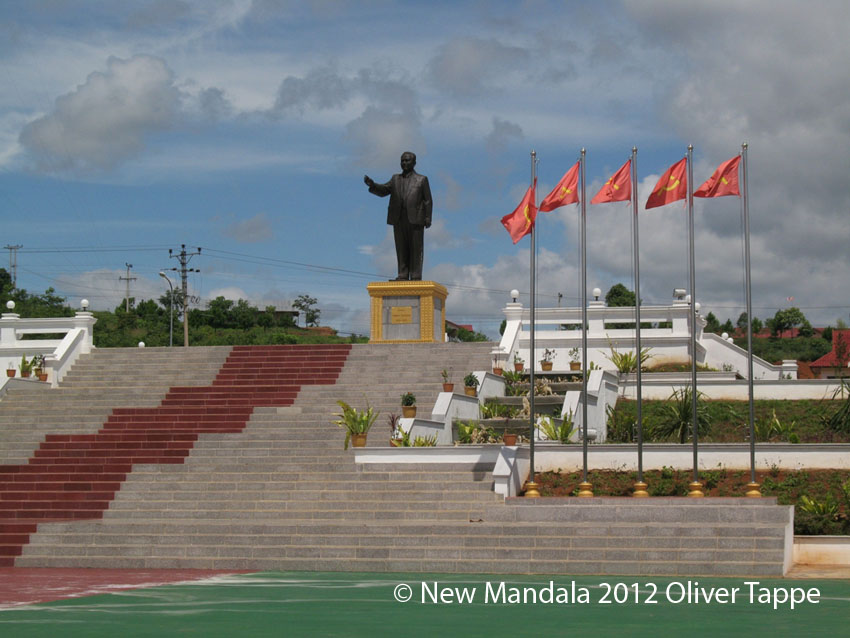A decade ago, the Lao People’s Revolutionary Party published a list of so-called ‘national ancestors’ (Lao: banphabulut haeng sat) to be commemorated through the construction of several statues (see here). Initially, the appearance of historical kings such as Fa Ngum and Chao Anouvong provoked some speculations about a revival of royalism in the Lao PDR. The excitement about communists who build statues of old kings has since then ebbed away. In 2010, the inauguration of Anouvong’s statue with its Buddhist ceremonial setting did not surprise anymore. It was just another colourful public event staged by the government to demonstrate its commitment to Lao cultural heritage. The statue of the famous king overlooking the Mekong is the most visible and largest statue in Laos.
Yet good old socialist iconography is not dead as the huge commemorative site for Kaysone Phomvihane in Viengxay demonstrates (see picture above). The 5 metre statue overlooks a two hectare dream of concrete in the old revolutionary stronghold. The site is sponsored by the Vietnamese government, which is assisting with other prestige projects as well such as the new cultural hall in Sam Neua, the provincial capital of Houaphan. While the Vietnamese engagement reflects Hanoi’s increasing economic interest in this border region, the Chinese support for the commemorative site for Souphanouvong in Luang Prabang (2007) may also be linked to China’s incentives for economic cooperation around the old royal city.
All this occurred to me when reading a Vientiane Times article last week “Revolutionary leaders honoured with statues” (also copied below this post). The article refers to the leaders in the original plan whose statues still await implementation: the former politburo members Phoun Sipaseuth, Phoumi Vongvichit, and Sisomphon Lovanxay, as well as three prominent ethnic minorities’ representatives within the Pathet Lao – Sithon Kommadam, Faydang Lobliayao, and Touya Xaychou. The only new name on this list is Nouhak Phoumsavan, Kaysone’s right hand, who was still alive during the initial selection of the national banphabulut. The monuments will be built in the respective home provinces of these historical personalities. Xieng Khouang, prominent landscape of war memory, will receive three additional commemorative sites.
It is remarkable that these revolutionary lieux de mémoire are not financed and assisted by the comrades from Hanoi – as the Kaysone Phomvihane Museum and the Lao People’s Army History Museum in Vientiane before – but by the Chinese government. This reminds us of the competition for influence in building venues for the 2009 SEA Games – only this time more on the provincial level. The question arises if this initiative is linked to the recent Lao-Vietnamese agreement to erect a statue of Ho Chi Minh in Khammouane province.
No doubt, the “politics of ritual and remembrance” in Laos still have various implications for both domestic and international political relations.
Another interesting fact is the projected size of the statues. I don’t want to overstate things, but it is remarkable that the statues for the politburo members will be taller than the ones for Sithon and the two Hmong, Faydang and Touya. In fact Sithon and Faydang had an ambivalent political position in post-revolutionary Laos and are officially commemorated mainly as military leaders of the ‘Lao Thoeng’ and ‘Lao Soung’ during the war. In this context it should be mentioned that there are plans as well to build commemorative sites for Ong Keo, Ong Khommadam, and Pho Kaduat who are remembered for their part “in mobilising Lao people to fight against foreign invaders (Vientiane Times, 22 May 2010) during the French colonial period.
Kaysone’s statues in Vientiane, Viengxay, and Savannakhet will remain the tallest ones among the revolutionary statues, of course.
Revolutionary leaders honoured with statues
(By Times Reporters, 10 January 2012)
The government will build statues of seven Lao revolutionary leaders in honour of their efforts to repel enemy forces during the Indochina War.
The Pathetlao daily newspaper reported yesterday that the statues will be erected in each leader’s home province.
Statues of Mr Nouhak Phoumsavanh and Mr Phoun Sipaseuth will be installed in Savannakhet province, Mr Phoumy Vongvichit’s in Xieng Khuang province, and Mr Sisomphone Lorvanxay’s in Borikhamxay province. The statues will measure 3.9 metres in height.
A statue of Mr Sithon Kommadam will be placed in Champassak province and of Mr Faidang Lorbiayao and Mr Touya Xaychou in Xieng Khuang province. These statues will be 3.5 metres high.
The Lao and Chinese governments will be responsible for creating the statues.
An agreement for the project was signed in Vientiane last week by Kaysone Phomvihane Museum Committee Deputy Head Mr Bounkhian Soulivong and an expert from China, Mr Cheng Bing.
Mr Bounkhian told Vientiane Times yesterday the statues will represent the lifetime achievements of the revolutionary leaders and will set an example and provide inspiration for future generations. They will also remind people of the wisdom and sacrifices of these brave men and shed more light on this important period of Lao history.
It will take four months to build the statues. Under the agreement, Laos will fund 50 percent of the cost of the project and the Chinese will invite Lao officials to give their opinion on the proposed design of the statues.
 Facebook
Facebook  Twitter
Twitter  Soundcloud
Soundcloud  Youtube
Youtube  Rss
Rss 